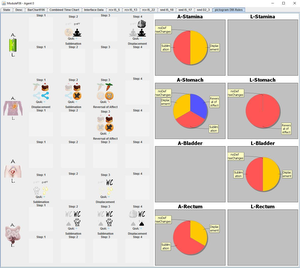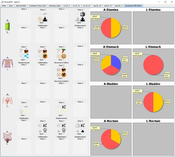Information
- Publication Type: Master Thesis
- Workgroup(s)/Project(s):
- Date: September 2017
- Date (Start): 10. July 2017
- Date (End): 11. September 2017
- TU Wien Library:
- Diploma Examination: 11. September 2017
- First Supervisor: Michael Wimmer
Abstract
SiMA (Simulation of the Mental Apparatus & Applications) is an interdisciplinary project, in which technicians and psychoanalysts cooperatively develop an implementable model of a decision-making unit based on the human psychological apparatus. Particular attention is attributed to designing the developed system akin to the human model in its functions (and its behavior). This includes the im-plementation of social rules and defense mechanisms. Together they form a bionically inspired filter mechanism for the agent's sensory data. The filter mechanism allows the user to identify and resolve conflicts arising between the agent’s perception and goals or implemented social rules. In this work, the SiMA project is further developed iteratively, following a use-case-driven methodo-logical approach. The basis is psychoanalytic use cases, which depict human behavior. The current use case revolves around the refinement of defense mechanisms. To fulfill this use case it is necessary to enhance the defense mechanisms to the next development stage. This includes the formulation of filter rules, knowledge representation for mapping these filter rules and validating their visualization possibilities and their influence on decision making. Additionally, the infrastructure for implementing the current use case has to be advanced further in order to enable validation with the entire system. This necessitates the development of an inventory system and new actions for the agent. After analyzing different input possibilities and knowledge representations regarding their suitability for the SiMA model, it could be shown that no existing model meets the specific requirements for flexibility and legibility. As a result, a separate input and memory format was developed for the filter rules and integrated into the existing model. The approach was embedded into the existing Java im-plementation of the SiMA model and tested in a multi-agent simulation environment (MASON). The simulation results supported eligibility of the newly developed rule format and highlighted the poten-tial applications for the use of this bionically inspired filter mechanism.Additional Files and Images
Weblinks
No further information available.BibTeX
@mastersthesis{JORDAKIEVA-2017-VFR,
title = "Visualization of Filter Rules in Autonomous Software-Agents",
author = "Ivalina Jordakieva",
year = "2017",
abstract = "SiMA (Simulation of the Mental Apparatus & Applications)
is an interdisciplinary project, in which technicians and
psychoanalysts cooperatively develop an implementable model
of a decision-making unit based on the human psychological
apparatus. Particular attention is attributed to designing
the developed system akin to the human model in its
functions (and its behavior). This includes the
im-plementation of social rules and defense mechanisms.
Together they form a bionically inspired filter mechanism
for the agent's sensory data. The filter mechanism allows
the user to identify and resolve conflicts arising between
the agent’s perception and goals or implemented social
rules. In this work, the SiMA project is further developed
iteratively, following a use-case-driven methodo-logical
approach. The basis is psychoanalytic use cases, which
depict human behavior. The current use case revolves around
the refinement of defense mechanisms. To fulfill this use
case it is necessary to enhance the defense mechanisms to
the next development stage. This includes the formulation of
filter rules, knowledge representation for mapping these
filter rules and validating their visualization
possibilities and their influence on decision making.
Additionally, the infrastructure for implementing the
current use case has to be advanced further in order to
enable validation with the entire system. This necessitates
the development of an inventory system and new actions for
the agent. After analyzing different input possibilities and
knowledge representations regarding their suitability for
the SiMA model, it could be shown that no existing model
meets the specific requirements for flexibility and
legibility. As a result, a separate input and memory format
was developed for the filter rules and integrated into the
existing model. The approach was embedded into the existing
Java im-plementation of the SiMA model and tested in a
multi-agent simulation environment (MASON). The simulation
results supported eligibility of the newly developed rule
format and highlighted the poten-tial applications for the
use of this bionically inspired filter mechanism.",
month = sep,
address = "Favoritenstrasse 9-11/E193-02, A-1040 Vienna, Austria",
school = "Institute of Computer Graphics and Algorithms, Vienna
University of Technology ",
URL = "https://www.cg.tuwien.ac.at/research/publications/2017/JORDAKIEVA-2017-VFR/",
}

 poster
poster thesis
thesis


